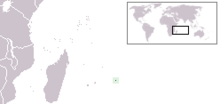| Rodrigues night heron | |
|---|---|

| |
| Subfossil skull, limb bones, and sternum, 1873 | |
| Scientific classification | |
| Domain: | Eukaryota |
| Kingdom: | Animalia |
| Phylum: | Chordata |
| Class: | Aves |
| Order: | Pelecaniformes |
| Family: | Ardeidae |
| Genus: | Nycticorax |
| Species: | †N. megacephalus
|
| Binomial name | |
| †Nycticorax megacephalus (Milne-Edwards, 1873)
| |

| |
| Location of Rodrigues | |
| Synonyms | |
|
Ardea megacephala Milne-Edwards, 1873 | |
The Rodrigues night heron (Nycticorax megacephalus) is an extinct species of heron that was endemic to the Mascarene island of Rodrigues in the Indian Ocean. The species was first mentioned as "bitterns" in two accounts from 1691–1693 and 1725–1726, and these were correlated with subfossil remains found and described in the latter part of the 19th century. The bones showed that the bird was a heron, first named Ardea megacephala in 1873, but moved to the night heron genus Nycticorax in 1879 after more remains were described. The specific name megacephala is Greek for "great-headed". Two related extinct species from the other Mascarene islands have also been identified from accounts and remains: the Mauritius night heron and the Réunion night heron.
The Rodrigues night heron was robust, its bill was comparatively large, stout and straight, and its legs were short and strong. It is estimated to have been 60 cm (24 in) long, and its appearance in life is uncertain. There was marked sexual dimorphism, males being larger. Little is known about the bird's behaviour, but the contemporary accounts indicate that it ate lizards (probably the Rodrigues day gecko), was adapted to running, and although able to fly, rarely did so. Examinations of the known remains have confirmed its terrestrial adaptations; one researcher thought the species flightless but this idea has not been accepted by others. The species could not be found by 1763, and it is thought to have been driven to extinction by human-related factors such as the introduction of cats.
- ^ BirdLife International (2016). "Nycticorax megacephalus". IUCN Red List of Threatened Species. 2016: e.T22728787A94996659. doi:10.2305/IUCN.UK.2016-3.RLTS.T22728787A94996659.en. Retrieved 12 November 2021.
